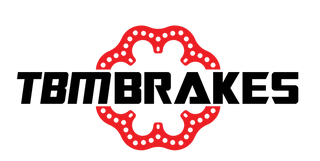FAQ
Contrary to popular belief, the number of pistons has nothing to do with caliper performance. More pistons don’t necessarily mean more clamping force. Clamping force comes from caliper rigidity and piston surface area. Two larger pistons in a given space will provide more surface area than three smaller ones. Claims about enhanced pad force distribution are also mostly irrelevant in real-world torque output.
The Revolution Rotor is designed for high performance and durability. It optimizes heat dissipation and rotating weight, improving acceleration and braking. Due to its proprietary manufacturing, it withstands high thermal abuse without warping or cracking, outperforming many heavier rotors while costing less than horsepower upgrades.
To better reflect our core business and growth beyond our grassroots origins, we rebranded from "The Brake Man" to TBM Brakes. This name reflects our commitment to top-tier performance components and service across all motorsports.
Pad taper is primarily caused by caliper flex. TBM Brakes calipers have superior rigidity, significantly reducing flex even under extreme pressure, resulting in more even wear, longer pad life, and improved handling. Brake drag is the leading cause of mid-corner push, and our Zero Drag calipers help prevent it.
Silicone brake fluid is incompatible with most brake system seals and can cause swelling, brake lockup, and pedal inconsistency. We recommend DOT 5.1 Xtreme 6, DOT 3, or DOT 4 fluids for optimal performance and safety.
Our calipers offer unmatched performance and cost savings through superior durability, Zero Drag technology, and significantly reduced pad wear. The true cost of a product includes long-term use and maintenance—not just the upfront price.
They lack sufficient clamping force in a single unit. TBM calipers are rated at 1500 psi and designed to deliver maximum force without deflection. One properly designed caliper does the job of two and reduces unsprung weight, drag, and cost.
Braided lines expand under pressure, increasing fluid volume and pedal travel. -3 hard lines prevent this, delivering quicker caliper response and better brake feel, especially critical at high speeds.
Smaller rotors reduce rotating weight, improving acceleration and braking. Our calipers provide enough clamping force that oversized rotors aren’t necessary, unless for extreme heat dissipation needs.
Residual valves maintain line pressure to prevent reverse flow, especially when the master cylinder is lower than the calipers. They reduce pedal travel and improve safety. Our valves are precisely rated and will not cause drag with our rigid calipers.
1-piece rotors are low cost and best for light use. 2-piece rotors reduce unsprung weight and improve heat management. Floating rotors have limited use cases and may lose effectiveness due to thermal expansion. For most users, fixed 2-piece rotors offer the best value and performance.
Temperature paints help determine pad heat ranges for optimal performance. Use multiple paints across rotor surfaces to monitor real-world temps. Single-temperature paints offer more accuracy than color-change types. Data helps you select the best pad compound and proves our calipers reduce rotor temps.
Brake pads must be thermally matched to the rotor and maintain consistent torque. Flatter torque curves prevent balance shift during heat cycles. Stability and repeatability are more important than raw friction.
Pressure gauges let you fine-tune front/rear brake bias and diagnose failing master cylinders. They help maximize deceleration and consistency by confirming caliper pressure during racing conditions.
Scuffing removes transfer layers that cause uneven pad contact, vibration, and premature lockup. It ensures smooth, consistent braking and is especially important when installing new pads with different compounds.
Experience. Our nearly 50 years of motorsports expertise ensures our components are properly applied and supported. We help customers unlock performance advantages unique to our Zero Drag technology, especially in demanding applications.
If ordering new axles, use the following:
- Hub register: 3.060” max
- Flange OD: 6.245” max
- Brake offset: any (2.33”, 2.50”, 2.83” are common)
- Lug pattern: 5 on 4.5”, 5 on 4.75”, or 5 on 5”
- Wheel stud diameter: 1/2”, 5/8”, or 11/16”
Most existing axles will work, but check the above to be sure.
